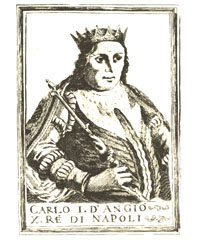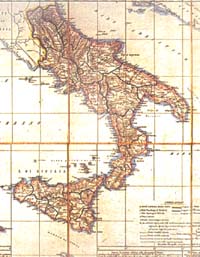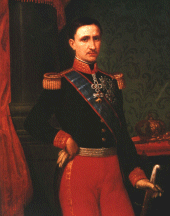The Altavilla (Hauteville) and the Creation of the “Kingdom”

It was the “Kingdom” par excellence. Its territory was delineated since the very first years of its creation under Roger II of Altavilla and remained unchanged along the centuries until its fall in 1861: its northern boundary followed a line that stretched out from Civitella del Tronto (south of Ascoli) to Gaeta and touched Leonessa, L’Aquila (north of Pontecorvo) and then continued south to the Tyrrhenian Sea; its southern boundary was the sea itself, including Sicily. After the fall of the Roman Empire, part of the territories that would then form the Kingdom were under the Byzantine rule (Southern Apulia, Calabria, Sicily and the Duchy of Naples); others were under the Longobard rule (the Duchy of Benevento); in the IX century Sicily fell under Muslim rule. In the subsequent centuries, especially in the 11th century, the geopolitical situation of southern Italy showed a sad breaking up into small local states, whereas the ancient Byzantine and Longobard dominions gradually lost the control of the situation.
A sort of “war of all against all” was the gradual outcome of this situation, worsened by the continuous Saracen raids. The South of Italy grew weaker and poorer: the Normans, led by the bold family of the Altavilla (Hauteville) were able to profit of this situation.
Around the 11th century the first Norman mercenaries came to enrol in the armies of the various lords fighting each other; in this mercenary policy, the Altavilla stood out and were able to create an earldom of their own in Melfi in 1043.
From that moment on, their political and military expansion was steady (especially under Robert the Guiscard, who conquered Apulia and Calabria) until they meddled also in the War of Investitures and were unscrupulously able to make the Pontiffs acknowledge their infeudation of the Church’s Southern dominions (in 1091 they expelled the Muslims from Sicily). Then, in 1130, Roger II of Altavilla (1101-1154) succeeded in convincing Pope Anacletus II to proclaim him King of Sicily, Apulia and Calabria (although he was the Pope’s vassal) and subsequently ruled also on Capua, Benevento and Naples. That was the formal birth of the Kingdom of Naples, at that time called “Kingdom of Sicily”.
William I the Evil (1154-1166), William II the Good (1166-1189), Tancred (1189-1194), and William III (1194) succeeded Roger II.
The “Kingdom”
The Norman Dynasty died out with Constance of Altavilla, wife of the Emperor of the Sacred Roman Empire Henry VI Hohenstaufen (Frederic Barbarossa’s son) and mother of Frederic II Hohenstaufen, who, at the death of his father in 1197, inherited the Empire and the Kingdom (he was born in Jesi and brought up in Palermo). After Frederic II’s death in 1250, his illegitimate son, Manfred, became lord-lieutenant of the Kingdom as regent on behalf of his step-brother Conrad IV, who died prematurely in 1254; Manfred then held the regency on behalf of Conrad’s son, Conrad the Younger Hohenstaufen, but in 1258 he broke off with his nephew, proclaimed himself King of Sicily and resumed the anticlerical policy of his father.
Urban VI first and Clement IV later fostered the coming to Italy of Charles of Anjou, brother of the King of France Louis IX (the Saint), who met and killed the Ghibelline Manfred at Benevento in 1266. But Conrad the Young turned up and claimed dynastic rights on the Kingdom; Charles met him at Tagliacozzo in 1268 and defeated him. At first, he had him arrested, but then he ordered his beheading on Piazza del Mercato in Naples. In this way, Charles could take the title of Charles I of Anjou King of Sicily, and start the Angevin – thus Capetian – rule on the Kingdom. Due to the consequences of the War of Vespers, he lost Sicily in 1282 in favour of Peter III of Aragon (who had married Constance, Manfred’s daughter) who became King of Sicily (1282-1285). So the kingdom was divided into Kingdom of Naples, under the Angevins, and Kingdom of Sicily, under the Aragoneses.
The Kingdom of Naples under the Angevins and the Aragoneses

The Angevins ruled over the continental part until 1442, when Alfonso of Aragon finally won the war against them (broke out because Joan II of Anjou had initially appointed Alfonso as her heir and subsequently withdrawn his appointment in favour of a French distant relative of hers), had a triumphal entry in Naples and unified again the Kingdom. His son Charles II (1285-1309), and, after him, Robert the Wise (1309-1343), Joan I (1343-1381), Charles III of Durrhes (1381-1386), Ladislaus of Durrhes (1386-1414), Joan II of Durrhes (1414-1435), Louis III (1435-1438), René (1438-1442) succeeded Charles I in the rule of Naples.

In 1443 the Kingdom of Naples was conquered by Alfonso V of Aragon (1443-1458). His son Ferdinand I (1458-1494) – the famous Ferrante – succeeded him and remained King of Naples only (he never reigned over Sicily). His son Alfonso II (1494-1495), was temporarily dethroned by Charles VIII of France; but the Kingdom immediately came back to the Aragoneses with Ferdinand II (1495-96) and Frederic (1496-1501), until, in 1504, Ferdinand the Catholic (King of Aragon, Sicily and Spain – after his marriage with Isabel of Castile), united the Kingdom of Naples to that of Spain and Sicily. From this moment on, the Kingdom of Naples (and that of Sicily) became in all respects part of the Kingdom of Spain and were ruled by a Viceroy for about two centuries.
The Kingdom of Sicily under the Aragoneses
In Sicily, James II (1285-1296), Frederic II (1296-1336), Peter II (1336-1342), Louis (1342-1355), Frederic III (1355-1377), Martin I (1377-1409), Martin II (1409) succeeded Peter III as kings of Sicily. In 1412 the Kingdom of Sicily was united to the Kingdom of Aragon: the following kings ruled over this new kingdom: Ferdinand I (1412-1416), Alfonso the Generous (1416-1458), John (1458-1479), Ferdinand the Catholic (1479-1516). Under Ferdinand the Catholic, who married Isabel of Castile and founded with her the Kingdom of Spain, Sicily became integral part of the Kingdom of Naples and of Spain.
The Vice-royalty
From 1504 to 1713 the Kingdom of Naples was united to the Kingdom of Spain. When Ferdinand the Catholic died, Charles I of Habsburg became king of Spain, and in 1519 also Emperor of the Sacred Roman Empire with the name of Charles V. Therefore he was also King of Naples and Sicily in all respects.
His son Philip II (1556-1598) succeeded him as King of Spain; and after him Spain (and therefore Naples and Sicily, which were ruled by a viceroy appointed by the King) was ruled by: Philip III (1598-1621), Philip IV (1621-1665), Charles II (1665-1700). Charles II of Habsburg-Spain died without heirs and appointed Philip of Anjou as his successor. Philip of Anjou was nephew of Louis XIV, and was preferred to Charles of Habsburg-Austria; he took the name of Philip V of Bourbon, King of Spain; this caused the War of the Spanish Succession (1700-1713), whose winner was Philip V, who, in exchange for his international acknowledgement as lawful king of Spain, had to give the Kingdom of Naples and of Sicily to the Habsburg. So, from 1713 the “Vice-royalty” was again under Habsburg rule, although this time the Habsburgs of Austria were the rulers: it therefore became an integral part of the Sacred Roman Empire and was ruled by Emperor Charles VI. Moreover, from 1714 to 1720 Sicily was given to King Victor Amadeus of Savoy, but afterwards it came back to the Habsburg.
The Bourbon Two Sicilies, restorers of the Kingdom

In 1734, Charles of Bourbon (King of Naples and Sicily from 1734 to 1759), son of Philip V of Spain and Elisabeth Farnese, conquered the Crowns of Naples and Sicily, and restored a united and independent kingdom. After two centuries of political dependence, the “Kingdom” became again an independent State under the lead of the Bourbon of Naples and Sicily.

After Charles of Bourbon, the kingdom was ruled by: Ferdinand IV (1759-1825), from 1814 Ferdinand I of the Two Sicilies; Francis I (1825-1830), Ferdinand II (1830-1859), Francis II, who lost the kingdom in 1860, when Victor Emanuel II of Savoy conquered it and the independent Kingdom ceased to exist as such.





